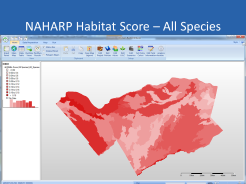
Humankind benefits from a multitude of resources and processes that are supplied by natural ecosystems. Collectively, these benefits are known as Ecosystem Services and include products like clean drinking water, wildlife, recreation opportunities, cleanup of wastes, and reduced atmospheric C02. While scientists and environmentalists have discussed ecosystem services for decades, these services were popularized and their definitions formalized by the United Nations 2004 Millennium Ecosystem Assessment (MA), a four-year study involving more than 1,300 scientists worldwide. This grouped ecosystem services into four broad categories: provisioning, such as the production of food and water; regulating, such as the control of climate and disease; supporting, such as nutrient cycles and crop pollination; and cultural, such as spiritual and recreational benefits.
A major challenge has been quantifying these ecosystem services so that their benefits can be directly estimated. This is important in developing ecosystem service markets, setting policy, and informing land use decision-making. Common Futures can assist in this process. Our scientists and engineers are experienced at modeling a variety of ecosystem services, quantifying changes in these services resulting from changes in management or policy, and performing trade-off analyses comparing impacts of choices on multiple "bundled" ecosystem services.
Application areas for Ecosystem Services assessment include:
The outcome of this process is a set of maps (GIS coverages) reflecting trajectories of change, and provide estimates of the value of the suite of ecosystem services being examined.
Understanding how anticipated climate change may affect land use generally, and agriculture specifically, in terms of impacts on food production, cropping systems pattern, water and air quality, and habitat provisioning, in the eastern portion of Ontario, Canada.
Common Futures developed coupled, spatially explicit models of cropping systems dynamics, land use, nutrient fate and transport, along with a suite of indicator models for a variety of food production, water quality and habitat metrics, in partnershp with Agriculture Canada and Environment Canada researchers. These coupled models were used to explore a five policy/climate scenarios for future change in the agriculture system.
A set of maps and summary statistics for the five scenarios, reflecting a wide variety of land use, habitat and water quality indices, reflecting the policy choices captured in each scenario.
